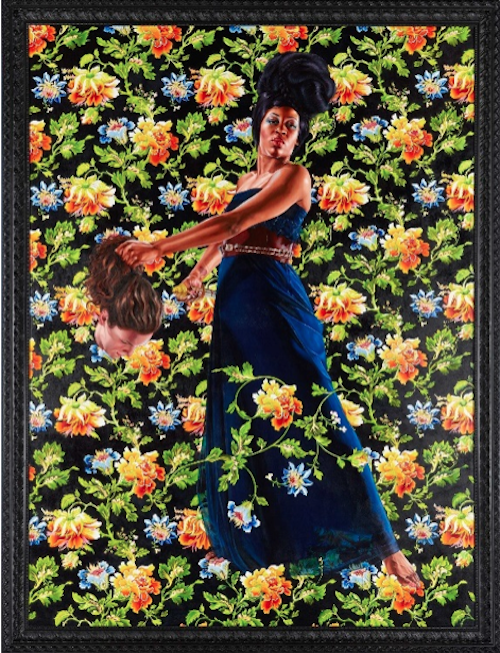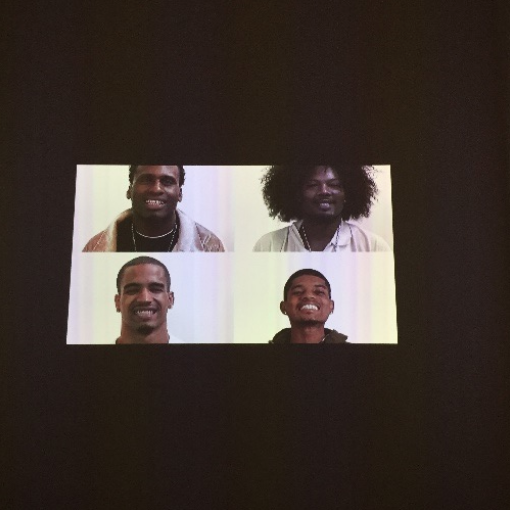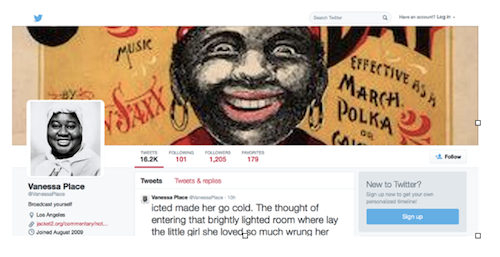NNNGGGGGGHHHHUUUUUGGGGHHHH HHHHHHHHHHHHHHH /a flesh sound / a sound of strangle / Your cup must be filled

“I ask you, O! Americans!” David Walker calls to his audience in his 1829 Appeal in Four Articles; Together with a Preamble to the Colored Citizens of the World, but in Particular, And Very Expressly To Those of The United States of America, “can you deny these charges?” the charges of “having subjugated us [African-Americans] under you, added to these miseries, by insulting us in telling us to our face, because we are helpless that we are not of the human family?” In exhorting free and enslaved blacks alike to take an active role in combating their oppression, the Appeal more than alludes to a frightening day of reckoning (on earth and in heaven) for white Americans “who have done us so much injury that you will never be able to repent. Your cup must be filled. You want us for your slaves and shall have enough of us—God is just, who will give you your fill of us.” Their judgment would be dealt by God and it would be harsh, for the obscenely cruel nature of American slavery was, for Walker, perversely un-Christian. Inasmuch as the Appeal shows how antithetical American slavery is to Christianity, its power lies in couching its extreme position within Judeo-Christian rhetoric and calls to resist the poisonous effects of racism and racism-induced ignorance by reminding whites and blacks that “America is more our country, than it is the whites—we have enriched it with our blood and tears. The greatest riches in all America have arisen from our blood and tears…” (Walker 1829). This reminds white Americans not only of the bodies used to secure American capitalist dominance, but also calls African-Americans together as a powerful collective force. Walker uses the orality of the sacred style to speak to and unify blacks who occupy the places of slave and ex-slave—a curious non-place in American society—and to achieve a radical break with slave narratives and slavery apologist texts like Jupiter Hammon’s Address by using his “pulpit” to agitate forcefully for black resistance and liberation.
Walker was not a preacher, but he was clearly well-versed in the sacred style rhetoric that is now widely known: according to Geneva Smitherman in Talkin and Testifyin, “the preacher imitations done by popular black comedians Flip Wilson and Richard Pryor” were heavily circulated and found their way into a cultural stereotype (Smitherman 87). The nature of the sermon prefigures a certain set of conditions: that there is at least a single voice speaking that demands to be heard, and that there is an audience gathered (free or captive) that can hear it. Not unlike the Greco-Roman (the Homeric epics) and Anglo-Saxon (Beowulf) bardic traditions of orally performed sociologically relevant “tales of the tribe,” or more aptly, the griot traditions of Africa (such as the griot-sustained Epic of Sundiata (Mali Epic of Sun-Jara)) the rhetorical gesture of the sermon locates Walker in a fertile, if liminal, space. His “pulpit” stands before both blacks and whites, and between freedom and citizenship. Walker was an educated free black man who could do more than just “write as well as any white man” (Walker 20), and was consequently in a place very distinct from that of black slaves and other black freedmen who were not educated beyond obtaining proper penmanship. Yet in the antebellum North or South, these achievements did not grant him a citizenship on par with that of whites. By locating the African-in-America’s plight among the oppressed of the Bible, Walker also participates in a collective activity articulated by Arthur A. Schomburg in which “The American Negro must remake his past in order to make his future” to “restore what slavery took away.” In a country where Manifest Destiny and American exceptionalism contribute to an orthodoxy of thinking about “America as the one country where it is unnecessary to have a past, what is a luxury for the nation as a whole becomes a prime social necessity for the Negro” (Schomburg in Locke, 1925). Locating African-American collective identity in Africanist traditions will become a major tenet in Black Power and the Black Arts Movement. In Walker’s time it was more productive to locate African-American oppression and slavery as part of the collective histories of Biblical narratives that promised, if not this-worldly then otherworldly justice for the oppressed and their oppressors.
To return to the opening lines, in questioning his white audience Walker conceptually collapses “American”-ness and whiteness into a single entity: “I ask you, O! Americans,” “can you deny these charges?” “having subjugated us under you, added to these miseries, by insulting us in telling us to our face, because we are helpless that we are not of the human family?” To be an American is to be white. The black man is not an American, he is a slave—or, as Amiri Baraka later formulates in Blues People, an ex-slave, as the single motive of bringing black peoples to America was for slavery. Even the freedman is not truly a citizen because, as Walker states, he will inevitably “be cheated out of his property by a white man” and be unable to do anything about it. Walker is keen to note, in Article I of the Appeal, that Indians, Greeks, Irish—“all the inhabitants of the earth, (except however, the sons of Africa), are called men.” “But we, (coloured people) and our children are brutes!” (emphasis in the original). Thus the black man in America has no name, not by which he is called or by which to call himself. His object status precludes his subjectivity.
During its time the Appeal constituted a radical break in the allowed and allowable speech of African-Americans. Walker reflects on the ways that blacks were punished and beaten for uttering prayers in a group, and expresses the knowledge that he himself might be threatened or killed for the transgressive nature of his speech, because nothing is more dangerous than a speaking object. By asserting subjectivity in responding to Walker, the-slave-as-object’s use value as a slave diminishes dramatically. Previous speech acts by blacks evidenced the colonization of the black (ex) slave’s language, in which slave narratives more often than not (needing the prefaces of whites to testify to the veracity of having been black-authored) were speech acts geared towards whites. Walker anticipates a poetics of Langston Hughes as well as Alain Locke’s “New Negro” writers in which blacks speak to blacks. Subjectivity through speech was either forcibly repressed or mediated by whites. Thus subjectivity-creating orality in African-American texts highlights the ways in which African-Americans, who as ex-slaves ironically had no place in the “American grain,” use oral forms to “git ovuh”—that is, to survive in a land where they are dispossessed to an extreme.
2.

At the Kehinde Wiley exhibit at the Brooklyn Museum of Art, I stood for nearly twenty minutes in front of his video “Smile.” According to the Utah Museum of Contemporary Art, this video “challenges four men, each in a separate quadrant of the screen, to smile directly into the camera’s lens for one full hour. As the minutes pass, the smile gradually contorts; the “smile” muscles spasm and each model’s performance becomes a strenuous test of endurance.” But that’s not exactly right, is it? The men are Black men. Why the Utah Museum description fails to mention this, as it is central to the project (it is the project), is curious. (Actually, it’s not curious.) And to call it a “test of endurance” is to put it passively. The man on the lower right holds his head high: he proudly wants his face to show. He tries very, very hard to sustain the grin. On the lower left, the man’s cheek muscles begin to quiver. He can barely hold the smile. It doesn’t take long to see that these aren’t smiles but grimaces. The man with the quivering cheek muscles starts to shake his head no. No no no. He can’t do it any longer—and yet he does! He shakes his head no but holds the grimace. Black men grinning and bearing it, grinning and bearing it, grimacing and bearing it, grimacing and bearing it. This smile is laborious. It is labor.

“Can you deny these charges?” –David Walker
3. In Case You Missed It
AWP 2015: Revisiting "Embracing the Verb of It: Black Poets Innovating
(Ruth Ellen Kocher, Duriel Harris, Douglas Kearney, Lillian-Yvonne Bertram)
The 2012 AWP panel "Embracing the Verb of It: Black Poets Innovating (or Innovative?)" was a standing-room-only event which captured a critical moment of evolution for experimental black poetics. This panel revisits the project of locating Black experimentation within the context of both innovation and a lyric tradition as homage to poets like Russell Atkins, Ed Roberson, Harryette Mullen, and Claudia Rankine. Writers will read and discuss the work of innovative lyricism.
Revisiting "Embracing the Verb of It: Black Poets Innovating": from ThisMouthIsMine on Vimeo.
A Final Anatomy of Melancholy is a poetry short (film) project inspired by the 17th century text by Robert Burton, Anatomy of Melancholy, in which he “samples” and draws on the work of other writers in order to make a comment on mankind and the issues of mankind. The graphic images come from my social media project #InstaManRuthEllenKocher where I use distorted images of high profile black men in combination with quotes from Ralph Ellison’s Invisible Man in order to draw attention to the commodification of the black male body. Those images, along with the poetry narration, finally came together for me this year. Like most black women, I look at the black men in my life with a palpable fear that each time I say goodbye might be my last. I am fixed in a place of constant fear that one of them (maybe all of them) will be used up and spit out, dismissed, humiliated, gunned down, arrested, beaten, or worse … From my vantage point, it is almost impossible to not feel defeated in the face of so many people who see the commodification and disposal of black men as last week’s news story and not a cultural crisis. The film is a call to action, to conversation, and social clarity. –Ruth Ellen Kocher
Undone. Unmade by thought and a revision of thought, the idea of an intimate and long-lasting self-betrayal, the image of washboard and fiddle, I would split and disperse but for being witnessed—both in the first instant of recognition, the initial iteration of the cognitive phrase, arrested amidst the interplay of thought, sense, and intuition (reading and writing with and alongside Scarry’s Body… and Hartman’s Scenes…) and in the return, the reprise, the public admission, utterance offered with and alongside Bertram, Kocher, and Kearney, at the lectern, revisiting the scene, my body, its form and substance visible, [the woman of the drowned girl,] considered, and affirmed.
In [this process of] withness, the texts, and these Black poets musicking, long time companions both, moved forward in language and form, present anticipating presence—mine and ours together. As if to relieve or at least ameliorate my distress, these willed permissions to continue, and leaving signs, continued finding words, shaping and making, imagining and pronouncing into materiality a shared reality, the assurance that I do not and will not have to endure alone.
And the pain, reprise, takes me to rage, and I remain present remembering indirection, stolen marks and sense, stirred saliva water, boiled piss soup, madness tea, a cold cutlass collar and many other things. And many things I leave for dead.
I will not buy my body, I think, and then, I do not have to. [I will make it.] Beware. – Duriel E. Harris
Lillian-Yvonne Bertram is the author of several books. Travesty Generator (Noemi Press, 2019) was a ...
Read Full Biography

